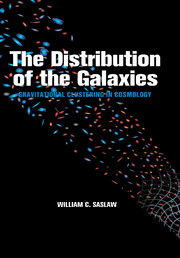Book contents
- Frontmatter
- Contents
- Prologue
- Part I Historical
- Part II Descriptions of Clustering
- Part III Gravity and Correlation Functions
- Part IV Gravity and Distribution Functions
- Part V Computer Experiments for Distribution Functions
- 31 Spatial Distribution Functions
- 32 Velocity Distribution Functions
- Part VI Observations of Distribution Functions
- Part VII Future Unfoldings
- Bibliography
- Index
32 - Velocity Distribution Functions
Published online by Cambridge University Press: 19 January 2010
- Frontmatter
- Contents
- Prologue
- Part I Historical
- Part II Descriptions of Clustering
- Part III Gravity and Correlation Functions
- Part IV Gravity and Distribution Functions
- Part V Computer Experiments for Distribution Functions
- 31 Spatial Distribution Functions
- 32 Velocity Distribution Functions
- Part VI Observations of Distribution Functions
- Part VII Future Unfoldings
- Bibliography
- Index
Summary
If you ask the special function
Of our never-ceasing motion
We reply, without compunction
That we haven't any notion.
Gilbert and SullivanTo the denizens of Iolanthe, we can only say with wonder that their motions gravitational are very much more rational, and easier to understand. Not individually, but statistically. To test the special function (29.4) for many-body motions in the context of cosmology we return to simulations in Sections 31.1–31.4.
Figures 15.5 and 15.6 in Section 15.3 illustrated some results of these simulations, which we now examine in more systematic detail. As in Section 31, we start with the simplest Ω0 = 1 case and identical masses. Then we explore the effects of smaller Ω0 and of components with different masses. Unlike the spatial distributions, velocity distribution functions are just beginning to be computed for experiments with dark matter and non-Poisson initial conditions. This is partly because the definition of which particles constitute a galaxy is still unsettled for such cases and partly because observations of f(v) for representative samples are just starting to be analyzed. Both these situations should improve. Then velocity distribution functions will become very valuable because they are more sensitive than the spatial distributions to some of the basic cosmological parameters.
Figure 32.1 shows the velocity distribution functions at four different expansion factors for the 4,000-body, Ω0 = 1, initially cold Poisson simulations with particles of identical masses.
Information
- Type
- Chapter
- Information
- The Distribution of the GalaxiesGravitational Clustering in Cosmology, pp. 416 - 426Publisher: Cambridge University PressPrint publication year: 1999
